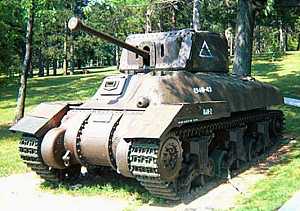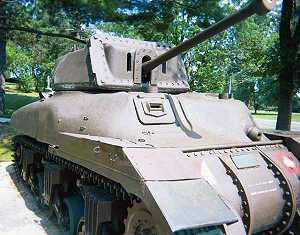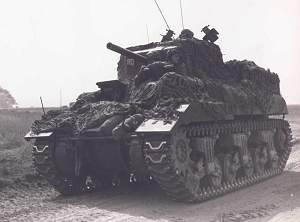Please
click on the photos at left (as applicable) to jump to large-scale copies
| The
Canadian Ram Cruiser Tank was
a unique Canadian evolution of the American M3 Medium (Grant/Lee). It had
been acknowledged as early as August 1940 that the British would be unable
to meet our requirements for cruiser tanks, and Montreal Locomotive Works
(a subsidiary of American Locomotive Co., which was already building tanks)
was designated as the Canadian Tank Arsenal. It was judged that the excessive
height and inferior armament configuration of the M3 series could be improved
upon locally, and a new tank was designed around the excellent M3 engine
and drivetrain. |
| Unfortunately,
during the process of design, the British specification for cruiser tanks
mounting a 2 pdr gun was adhered to, and the 60-inch turret ring of the
Grant was retained, thus restricting the Ram from ever being upgunned beyond
6 pdr. [then] Colonel Worthington himself had argued for the minimum of
a 75mm main gun, but was overrulled by the Interdepartmental Tank Committee
under the influence of the British Tank Mission. While this was happening,
however, British experience on the battlefield was already dictating the
necessity for a heavier main gun, and the early 2 pdr Ram did at least
get a turret with a readily detachable frontpiece, which could be removed
with gun in place and replaced by a 6pdr assembly. |
| The
prototype Ram rolled off the assembly line in June 1941, and general production
of the Ram I began that November. Within three months the line had been
changed to Ram II production, which continued until July 1943, at which
point the decision had been taken to re-equip British and Canadian units
with the abundant and better-armed U.S. Sherman. A total of 1948 Rams of
all marques were produced, the last 84 of which were the O.P. variant carrying
a dummy gun and two No. 19 Wireless sets for use by the FOOs (Forward Observation
Officers) of the Sexton-mounted artillery regiments then being formed. |
| In
its cruiser configuration, and limited by its small turret ring and 6 pdr
gun, the Ram never saw combat, but was used instead for the training of
armour crews in Great Britain. By late-summer 1944, with the war raging
in Northern Europe, even that function had all but ceased, but the Ram
found new life, and went on to do yeoman service, in a number of variants
including the Kangaroo armoured personnel carrier, Badger flame tank, Wallaby
ammunition tank, armoured gun tower (for the 17 pdr towed AT gun) and ARV.
Sadly, most of the Rams which survived the European war ended their time
as hard targets on a variety of tank ranges, and few examples remain. |
|
 |
Shown
here is an early production Ram II sitting in Worthington Tank Park at
Canadian Forces Base Borden. Note the sponson door, and the early, short-barrelled
Mk.III 6 pdr gun; the Ram I sported a 2 pdr main gun and a pistol port/vision
block (protectoscope) in the door. Details of the early M3 chassis are
readily visible here. All Rams carried variations of the Wright Continental
R-975 air-cooled 9-cylinder radial engine, the same engine equipping early
Shermans, M7 Priests and the Canadian Sexton S.P. Gun. Running on aviation
octane, this engine could carry the 32-ton Ram and its crew of five to
a maximum of 25 m.p.h. |
|
 |
This
close-in shot of the same vehicle shows details of the auxillary turret
and fender-mounted tool box, as well as the removeable 6 pdr mantlet.
Note that on this model, the protectoscope and port on the sponson door
had been eliminated in favour of a ventilator; this appears to have been
cut off and plated over in this example. Later production eliminated the
side door (and auxillary turret) altogether. |
|
 |
Elsewhere
at Worthington Park rests this late-production Ram II. Note that the auxillary
turret is gone, with the left-hand front hull redesigned to match the right
(driver's) side and a ball mount incorporated for the Browning .30 machinegun.
The gun here is a Mk.V 6 pdr with muzzle counterweight. The track shown
here is CDP (Canadian Dry Pin), but the Ram usually used any number of
variations of U.S. track as delineated on Hanno Spoelstra's excellent site
The
Sherman Register. |
|
 |
Another
view of the same example. Unfortunately, weather has taken its toll of
the vehicles displayed outside at Worthington Park, and all such vehicles
have been formly welded shut, thus preventing any kind of interior exploration
or documentation. It is interesting to note that the designation 'Ram'
is taken directly from the centrepiece of the Worthington family crest
- truly honour given where deserved. This was a tank before its time, but
ultimately doomed by the same shortsightedness which plagued British and
Commonweath armies so badly in the early years of the war. That it was
able to serve well nonetheless in its variant roles is a positive testament
indeed. |
|
 |
This
photo shows a Ram OP tank somewhere in Normandy; 84 of these were manufactured
at the very end of Ram production. It was a Ram II which had a dummy gun
in place on the exterior, and two No. 19 Wireless sets inside. These tanks
accompanied the Sexton S.P. gun regiments as mobile observation posts for
their FOOs, who up until this time had a fairly high attrition rate when
travelling on foot or by carrier with the infantry. We will endeavour to
present more information on this and other Ram variants as photographs
become available; in the meantime, please visit our section on the Ram
Kangaroo! |
|
| Source:
AFV #13 - RAM AND SEXTON, by Chris Ellis and Peter Chamberlain, Profile
Publications, England. |
|
 12 Feb 00
12 Feb 00 |
Back
to Canadian Armoured Corps |
|
Back
to Vehicles |
|
Recovery
of a Ram Kangaroo |
|
| Copyright
©
Geoff Winnington-Ball ,
1999 - 2000 All Rights Reserved |
|